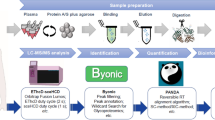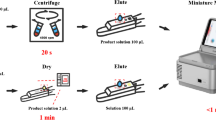Abstract
The postmortem determination of hyperglycaemic coma is quite difficult because of the lack of morphological findings and the difficult interpretation of biochemical parameters. Methylglyoxal (MG) is a reactive oxoaldehyde, which is mainly derived from glycolysis. An electrospray ionisation liquid chromatography–tandem mass spectrometric procedure for the determination of methylglyoxal in human serum and postmortem blood was developed. It involves protein precipitation with perchloric acid and a derivatisation step with 2,3-diaminonaphthalene. The assay was validated according to international guidelines. Serum samples from diabetics obtained at a diabetes clinic and from non-diabetics were used to assess data about reference concentrations in human serum. The assay showed linearity within the physiological concentrations in serum (5–500 ng/ml). Intraday imprecision at three concentrations was 10.3, 9.2 and 8.3 %, and interday imprecision was 15.3, 14.2 and 9.4 %; the limit of detection was 1.3 ng/ml, and limit of quantification, 3.2 ng/ml. One hundred and eighteen clinical (100 diabetics, 18 non-diabetics) and 98 forensic samples (84 non-diabetics, 14 in a status of hyperglycaemic coma) were measured. During life, diabetics showed significantly (p < 0.001) higher serum concentrations of MG than non-diabetics. After death, concentrations of MG increased significantly (p < 0.001). However, there was no correlation between the sum formula of Traub in vitreous humour and MG femoral blood concentrations (R = 0.237). This indicates that MG concentrations in the deceased cannot distinguish deaths due to a hyperglycaemic coma from other causes of death.




Similar content being viewed by others
References
Hess C, Musshoff F, Madea B (2011) Disorders of glucose metabolism-post mortem analyses in forensic cases: part I. Int J Legal Med 125:163–170
Musshoff F, Hess C, Madea B (2011) Disorders of glucose metabolism: post mortem analyses in forensic cases—part II. Int J Legal Med 125:171–180
Traub F. Methode zur Erkennung von tödlichen Zuckerstoffwechselstörungen an der Leiche (Diabetes mellitus und Hypoglykämie). Zbl Allg Path Anat 112: 390–399
Karlovsek MZ (2004) Diagnostic values of combined glucose and lactate values in cerebrospinal fluid and vitreous humour—our experiences. Forensic Sci Int 146:S19–S23
Kernbach G, Puschel K, Brinkmann B (1986) Biochemical measurements of glucose metabolism in relation to cause of death and postmortem effects. Z Rechtsmed 96:199–213
Palmiere C, Sporkert F, Vaucher P et al (2012) Is the formula of Traub still up to date in antemortem blood glucose level estimation? Int J Legal Med 126:407–413
Chen C, Glagov S, Mako M, Rochman H, Rubenstein AH (1983) Post-mortem glycosylated hemoglobin (HbA1c): evidence for a history of diabetes mellitus. Ann Clin Lab Sci 13:407–410
Igawa M, Munger JW, Hoffmann MR (1989) Analysis of aldehydes in cloud and fog water samples by HPLC post-column reaction detector. Environ Sci Technol 23:556–561
IARC Monographs on the Evaluation of Carcinogenic Risks to Humans (1991) Coffee, tea, mate, methylxanthines and methylglyoxal, vol 51. IARC, Lyon
Moree-Testa P, Saint-Jalm Y (1981) Determination of alpha-dicarbonyl compounds in cigarette smoke. J Chromatogr 217:197–208
Desai KM, Chang T, Wang H et al (2010) Oxidative stress and aging: is methylglyoxal the hidden enemy? Can J Physiol Pharmacol 88:273–284
Thornalley PJ (1996) Pharmacology of methylglyoxal: formation, modification of proteins and nucleic acids, and enzymatic detoxification—a role in pathogenesis and antiproliferative chemotherapy. Gen Pharmacol 27:565–573
Chaplen FW, Fahl WE, Cameron DC (1996) Method for determination of free intracellular and extracellular methylglyoxal in animal cells grown in culture. Anal Biochem 238:171–178
McLellan AC, Thornalley PJ, Benn J, Sonksen PH (1994) Glyoxalase system in clinical diabetes mellitus and correlation with diabetic complications. Clin Sci (Lond) 87:21–29
Hoffmann GF, Sweetman L (1991) O-(2,3,4,5,6-pentafluorobenzyl)oxime-trimethylsilyl ester derivatives for sensitive identification and quantitation of aldehydes, ketones, and oxoacids in biological fluids. Clin Chim Acta 199:237–242
Ohmori S, Mori M, Shiraha K, Kawase M (1989) Enzymology and molecular biology of carbonyl metabolism, vol 2. Liss, New York
Mugo SM, Bottaro CS (2008) Rapid analysis of alpha-dicarbonyl compounds by laser desorption/ionization mass spectrometry using 9-(3,4-diaminophenyl)acridine (DAA) as a reactive matrix. Rapid Commun Mass Spectrom 22:1087–1093
Peinado J, Lopez-Soriano FJ, Argiles JM (1986) The metabolism of acetone in the pregnant rat. Biosci Rep 6:983–989
Peters FT et al (2011) Anhang B zur Richtlinie der GTFCh zur Qualitätssicherung bei forensich-toxikologischen Untersuchungen: Anforderung an die Validierung von Analysensystemen. https://www.gtfch.org/cms/files/GTFCh_Richtlinie_Anhang%20B_Validierung_Version%201.pdf. Accessed 12 Mar 2012
Peters FT, Drummer OH, Musshoff F (2007) Validation of new methods. Forensic Sci Int 165:216–224
Beisswenger PJ, Howell SK, Touchette AD, Lal S, Szwergold BS (1999) Metformin reduces systemic methylglyoxal levels in type 2 diabetes. Diabetes 48:198–202
Odani H, Shinzato T, Matsumoto Y, Usami J, Maeda K (1999) Increase in three alpha, beta-dicarbonyl compound levels in human uremic plasma: specific in vivo determination of intermediates in advanced Maillard reaction. Biochem Biophys Res Commun 256:89–93
Han Y, Randell E, Vasdev S et al (2007) Plasma methylglyoxal and glyoxal are elevated and related to early membrane alteration in young, complication-free patients with type 1 diabetes. Mol Cell Biochem 305:123–131
McLellan AC, Phillips SA, Thornalley PJ (1992) The assay of methylglyoxal in biological systems by derivatization with 1,2-diamino-4,5-dimethoxybenzene. Anal Biochem 206:17–23
Dhar A, Desai K, Liu J, Wu L (2009) Methylglyoxal, protein binding and biological samples: are we getting the true measure? J Chromatogr B Anal Technol Biomed Life Sci 877:1093–1100
Chaplen FW, Fahl WE, Cameron DC (1998) Evidence of high levels of methylglyoxal in cultured Chinese hamster ovary cells. Proc Natl Acad Sci U S A 95:5533–5538
Ahmed N, Thornalley PJ (2002) Chromatographic assay of glycation adducts in human serum albumin glycated in vitro by derivatization with 6-aminoquinolyl-N-hydroxysuccinimidyl-carbamate and intrinsic fluorescence. Biochem J 364:15–24
Lo TW, Westwood ME, McLellan AC, Selwood T, Thornalley PJ (1994) Binding and modification of proteins by methylglyoxal under physiological conditions. A kinetic and mechanistic study with N alpha-acetylarginine, N alpha-acetylcysteine, and N alpha-acetyllysine, and bovine serum albumin. J Biol Chem 269:32299–32305
Ahmed MU, Brinkmann FE, Degenhardt TP, Thorpe SR, Baynes JW (1997) N-epsilon-(carboxyethyl)lysine, a product of the chemical modification of proteins by methylglyoxal, increases with age in human lens proteins. Biochem J 324:565–570
Kalapos MP (1994) Methylglyoxal toxicity in mammals. Toxicol Lett 73:3–24
Thornalley PJ, Hooper NI, Jennings PE et al (1989) The human red blood cell glyoxalase system in diabetes mellitus. Diabetes Res Clin Pract 7:115–120
Acknowledgements
This study was supported by the Deutsche Forschungsgemeinschaft (DFG, project number, GZ-MU-1343/8-1). We would like to thank Pia Aymans and Yvonne Mattern for their help in the laboratory and Julia Brünig and Charlotte Meister for sample collection.
Conflict of interest
None.
Author information
Authors and Affiliations
Corresponding author
Rights and permissions
About this article
Cite this article
Hess, C., Stratmann, B., Quester, W. et al. Clinical and forensic examinations of glycaemic marker methylglyoxal by means of high performance liquid chromatography–tandem mass spectrometry. Int J Legal Med 127, 385–393 (2013). https://doi.org/10.1007/s00414-012-0740-4
Received:
Accepted:
Published:
Issue Date:
DOI: https://doi.org/10.1007/s00414-012-0740-4




